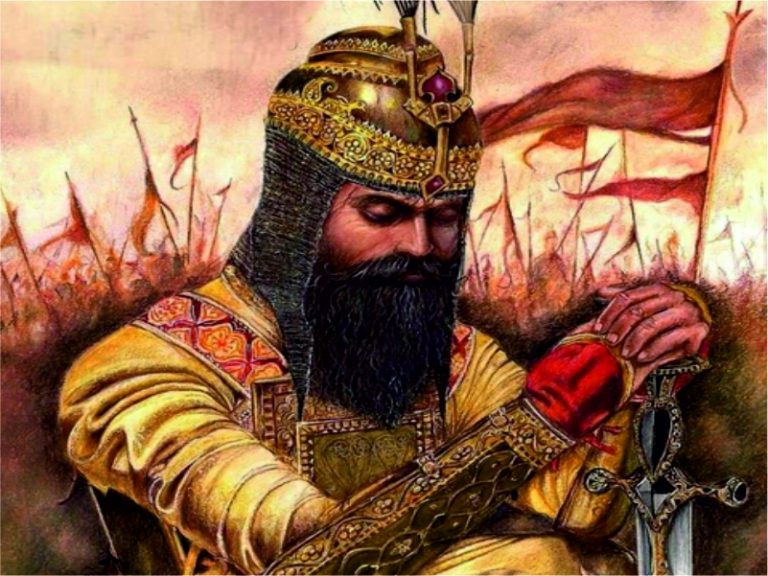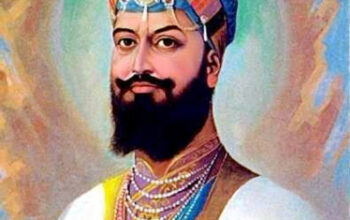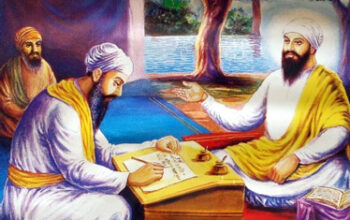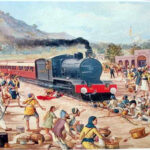“Ranjit Singh grasped the more obvious characteristics of the impulse given by Nanak and Gobind; he dexterously turned them to the purpose of his own material ambition, and he appeared to be an absolute monarch in the midst of willing and obedient subject.”
J.D. Cunningham, ‘History of the Sikhs’ P.15
Maharaja Ranjit Singh also popularly known as the ‘Lion of Panjab’ for his extra ordinary courage, stamina and generous character. His father was a local chief who died in battle when Ranjit Singh was only 12 years old. As if a born ruler with a natural genius of command he took over the complete control of his principality by the age of 17. He quickly realised that rivalry and disputes among the Sikh chieftains, ruling different confederacies, were inevitable. Therefore, when he was barely 25, Ranjit Singh started to carry out the task of abolishing these confederacies and completed it within four years, by sitting on the throne of Lahore in 1809 and bringing most of Panjab under his rule. He achieved this miracle not only through conquest by war, but also through diplomacy and negotiations.
It soon became apparent and appropriate for the British Government of the then India to extend a hand of friendship to the all-powerful Maharaja of Lahore. As such on 25th April 1809 and under the leadership of Sir Charles Metcalfe a treaty of non-aggression was signed between the two powers (see appendix). And again, on 26th October 1831 a meeting of ‘abiding friendship’ took place at ROPAR between the Maharaja and the British Governor General, Lord William Bentick. The treaty of non-interference with the British gave Ranjit Singh an opportunity to extend and consolidate his empire towards the north and west of Panjab, annexing Kashmir and N.W. Frontier Province including the Khyber. In 1839 Ranjit Singh had a second attack of paralysis, and on June 27th the ‘Lion of Panjab’ passed away.
HOW EUROPEANS SAW HIM
Victor Jacquemont (‘Letters from India’, 1834)
“The Panjab and its inhabitants please me much. Perhaps you will say that it is because I see them through a shower of gold; but the unsophisticated Sikhs of this country have a simplicity and open honesty of manner which a European relish the more after two years’ residence or travelling in India.”
“His (Ranjit Singh’s) conversation is like a nightmare. He is almost the first inquisitive Indian I have seen .…. He asked a hundred thousand questions to me about India, the British, Europe, Bonaparte, this world in general and the next, hell, paradise, the soul, God, the devil and a myriad of others of the same kind.”
Captain W. Murray (‘History of the Panjab’, 1846)
“Ranjit Singh has been likened to Mehemet Ali and to Napoleon. Mr Jacquemont terms him “a Bonaparte in miniature.” There are some points in which he resembles both; but estimating his character with reference to his circumstances and position, he is perhaps a more remarkable man than either.”
“It is difficult to suppress admiration in contemplating the career of such a man, who, with so many disadvantages, succeeded, with so few crimes, in elevating himself from a simple Sardar to be the Sovereign of a large kingdom, including Hindus and Mohammadans, as well as Sikhs, the only state in India not substantially under British Dominion.”
Lt.-Col Steinbach (‘The Panjab’, 1846)
“The treasure (of Maharaja Ranjit Singh) may be estimated to have amounted at his decease to about eight ‘crore’ of rupees in cash, or the same number of millions of pounds sterling, with jewels, shawls, horses, elephants etc., and several million more . . . . . . It is doubtful if any Court in Europe possesses such valuable jewels as the Court of Lahore.”
Alex Gardner (‘Soldier and Traveller – Memoirs of Alex Gardner’)
“The Maharaja was indeed one of those master-minds which only require opportunity to change the face of the globe. Ranjit Singh made a great and powerful nation from the disunited confederacies of the Sikhs and would have carried his conquests to Delhi or even farther, had it not been for the simultaneous rise and consolidation of the British Empire in India.”
THE FALL OF THE SIKH RAJ
When Maharaja Ranjit Singh died in 1839, the agents of the British East India Company had already started making clever plans to annex the last remaining independent territory in India. Very soon special cantonments were set up along the border with Panjab, and the seeds of dissent and dissatisfaction were sown among the contenders for the throne of Lahore as well as among ministers and generals.
By 1843, within a period of four years almost all important male members of Maharaja Ranjit Singh’s family and successors to the throne of Lahore were killed one after another, as a result of counter conspiracies affected by the two senior ministers. They were the two Dogra brothers, namely Dhian Singh and Gulab Singh* who were formerly honoured with the title of Raja Ji by the late Maharaja for their services. They had their own plans, which also suited their British friends very much. The only surviving member of the royal family was a young prince, aged six, named Daleep Singh. He was proclaimed as the Maharaja with his mother Maharani Jind Kaur acting as regent.
Apart from the throne, there was similar infighting and rivalry for the prime-minister ship and for the command of the Sikh Armies. The Sikh Generals had become too powerful in their own right. Soon the British agents were able to corrupt two of them as well, with promised rewards. They were Tej Singh and Lal Singh who later played a key role in the defeat of Sikh Armies during the Anglo-Sikh Wars between 1846-1849, the details of which, although extremely interesting, are not relevant in the present context.
Finally, on 29th March 1849 the young Maharaja Daleep Singh was removed from the throne of Lahore and his kingdom formally annexed to the British Empire. At first he was exiled from Panjab to Fatehgarh in U.P. (India) where he was converted to the Christian faith on 8th March 1853. Then he was taken to England in 1854, where he spent practically the rest of his life. In England, the young prince was, for some time, taken care of by the royal quarters under the patronage of Queen Victoria. Having grown up, he began to question the British of his rights of proper princely allowances and the restoration of his kingdom as was apparent from the treaty of Lahore in 1849. As his repeated requests were turned down, he became more desperate and erratic in his behaviour; he even tried to seek the help of the Ztar of Russia with a ‘childish’ plan to over throw the British from Panjab and eventually from India. Frustrated and disappointed he contacted some relatives in Panjab and left for India. After reaching Aden he renounced Christianity and reconverted to Sikhism. However, he was held by the British authorities and brought back. He was now totally demoralised and depressed. He had lost whatever little princely allowances he had and began to live the life of a pauper in Paris. He died of a broken heart on October 22, 1893.
*Extracts from Lord Harding’s letter to his wife Emily Harding.
10th February 1846: “I have a communication from Raja Gulab Singh which may lead to overtures for an arrangement; he is to be made a minister and says he is ready to do whatever we like to order.”
19th February 1846: “well, I have the ablest scoundrel in all Asia close to my camp – the Wazir Raja Gulab Singh – a good looking, clever-eyed man of 50 and yesterday he brought the little Maharaja to my Durbar tent to make his submission and pay tribute.”
1st March 1846: “I cannot say whether my policy in dealing with the Sikh nation will be approved or not . . .. .I have annexed a very rich district bounded by the river Beas to the Indian Empire chiefly to improve our frontiers. . . . . . I have made all the hill tribes touching our hill frontier independent of the Sikhs. . . . .. I have placed all these countries under a Rajput dynasty chief Raja Gulab Singh who is by religion a Hindu.”









